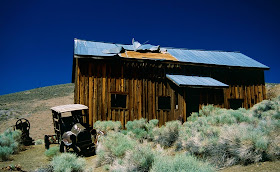I nominate Berlin-Ichthyosaur for America’s oddest-named state park. However, considering that many state parks are named to celebrate either history or scenery—Fremont Indian and Kodachrome Basin State Parks in Utah, for instance—perhaps this remote Nevada state park’s appellation suits it perfectly.
Let’s break down the park’s unusual hyphenated name and unearth the linkage between the two.
First, Berlin:
Given the chance to strike it rich from precious metals mining in the late 1800s, a town and all its infrastructure materialized before you could say “failed gold and silver mine”. The town of Berlin, with it’s less-than-successful production, was born and died in little more than a decade between the late 1890s and early 1900s.
The townsite remained largely ignored for 50 years before being established as a state park in 1957. Today the park service maintains Berlin in a state of “arrested decay”.
The Berlin ghost town tour is a self-guided journey into the past, through old mill sites and homesteads.
The miners left in a hurry when the mills closed, without looking back or taking the time to pack. Furniture, bottles, canned goods, cooking utensils, tools—even a jar of rattlesnake tails—all were left behind in their cabins. Only in a state as dry and sparsely populated as Nevada could these treasures be preserved for visitors to enjoy and discover decades later.
 |
| Berlin Townsite. The buildings from over 100 years ago are well-preserved. Notice the long and lonely entrance to the park. |
 |
| The townspeople even left their cars intact! |
Second, Ichthyosaur:
A vast inland sea once covered most of the state of Nevada. Inhabiting this sea were giant creatures, part fish and part lizard. The sea lizards hung around for 160 million years or so, through the Mesozoic and Jurassic periods, becoming extinct during the late Cretaceous period.
Their bones were covered by thousands of feet of mud and slime, which later hardened into shale and then uplifted. For tens of millions of years the shale eroded, exposing the prehistoric fossilized bones.
Enter those gold and silver miners, a few of whom discovered "rocks" shaped surprisingly like bowls. You guessed it. The peculiar rocks, used by miners as water dishes for their dogs, were later identified as vertebrae from the long-ago fish-lizards.
Dozens of fossilized ichthyosaur skeletons have been excavated near Berlin and thus these two historic sites—one of them 100 years old and the other 100 million years old—are explicitly linked.
 |
| The 60-foot long Ichthyosaurs were abundant and were the largest animals of their time. |
Odd name or not, Berlin-Ichthyosaur State Park is well off the beaten path but worth a visit if you’re traveling through central Nevada.
 |
| Up the road from Berlin townsite the park provides fourteen delightful campsites with sheltered picnic tables. A quarter mile nature trail leads to the fossil quarry. |






